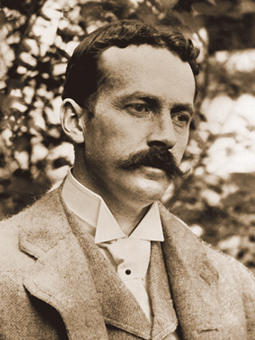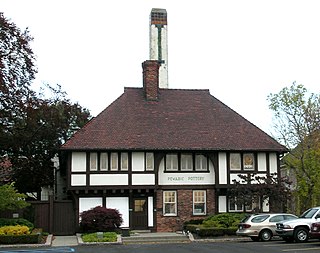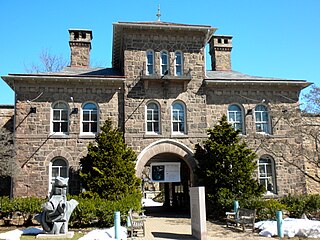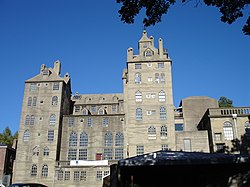
Bucks County is a county in the Commonwealth of Pennsylvania. As of the 2020 census, the population was 646,538, making it the fourth-most populous county in Pennsylvania. Its county seat is Doylestown. The county is named after the English county of Buckinghamshire.

Doylestown is a borough and the county seat of Bucks County, Pennsylvania. As of the 2020 census, the borough population was 8,300.

Henry Chapman Mercer was an American archeologist, artifact collector, tile-maker, and designer of three distinctive poured concrete structures: Fonthill, his home; the Moravian Pottery and Tile Works; and the Mercer Museum.

Pewabic Pottery is a ceramic studio and school in Detroit, Michigan. Founded in 1903, the studio is known for its iridescent glazes, some of which grace notable buildings such as the Shedd Aquarium and Basilica of the National Shrine of the Immaculate Conception. The pottery continues in operation today, and was designated a National Historic Landmark in 1991.

Fonthill, also known as Fonthill Castle, was the home of the American archeologist and tile maker Henry Chapman Mercer, in Doylestown, Pennsylvania.

The Moravian Pottery & Tile Works (MPTW) is a history museum which is located in Doylestown, Pennsylvania. It is owned by the County of Bucks, and operated by TileWorks of Bucks County, a 501c3 non-profit organization.

The Fountain House is located in the borough of Doylestown, Pennsylvania, in the central commercial district. The four-story building is steeped in local history and is a major landmark of the Bucks County area. It was added to the National Register of Historic Places in 1972.

The Michener Art Museum is a private, non-profit museum that is located in Doylestown, Bucks County, Pennsylvania. Founded in 1988, it was named for the Pulitzer Prize–winning writer James A. Michener, a Doylestown resident.

Henry Chapman was an American politician from Pennsylvania who served as a Democratic member of the U.S. House of Representatives for Pennsylvania's 7th congressional district from 1857 to 1859.

The Moravian Museum of Bethlehem, also known as the 1741 Gemeinhaus and the Lewis David de Schweinitz Residence, is a historic house museum at 66 West Church Street in Bethlehem, Pennsylvania. Built in 1741 to house the early Moravian community as well as the community's place of worship, the Saal, it is the oldest surviving building in Bethlehem, the largest surviving log house in continuous use in the U.S. and also significant for its association with the botanist and mycologist Lewis David de Schweinitz (1780–1834). It was declared a National Historic Landmark in 1975. The building is part of the Historic Moravian Bethlehem District which was designated as a National Historic Landmark District in 2012 and later named to the U.S. Tentative List in 2016 for nomination to the World Heritage List.

Dorchester Pottery Works is a historic site at 101-105 Victory Road in Dorchester, Massachusetts, a neighborhood of Boston. The Dorchester Pottery Works was founded in 1895 by George Henderson and made stoneware. The Dorchester Pottery Works closed in 1979. The building was designated as a Boston Landmark in 1980 and added to the National Register of Historic Places in 1985.
Mercer House, Mercer Hall, and variations, may refer to:

Cement City Historic District is a historic district in Donora, Pennsylvania. The district includes 80 Prairie School concrete residences built in 1916–17. The homes served as housing for employees of the American Steel and Wire Company. Poured-in-place concrete houses had become popular in large-scale housing developments at the time, partly thanks to promotion by Thomas Edison; the homes built in Donora used a newly patented construction method from the Lambie Concrete House Corporation. Building the houses required a combined 10,000 barrels of Portland cement.

The Doylestown Historic District is a national historic district located in Doylestown, Bucks County, Pennsylvania. The district is composed of one thousand fifty-five contributing buildings in the central business district and surrounding residential areas of Doylestown, including a variety of residential, commercial, industrial, and institutional buildings and notable examples of Late Victorian and Federal style architecture.

Fonthill, Mercer Museum and Moravian Pottery and Tile Works is a National Historic Landmark District located at Doylestown, Bucks County, Pennsylvania. It consists of three properties built by Henry Chapman Mercer (1856-1930) in a distinctive application of the principles of the Arts and Crafts movement, which are also notable for the early use of poured concrete: Fonthill, the Mercer Museum, and the Moravian Pottery and Tile Works. All three are now museum properties of the Bucks County Historical Society. The landmark designation for the group was made in 1985; each property is also individually listed on the National Register of Historic Places.

The Amory Ballroom is the only surviving remnant of a large summer estate house off Old Troy Road in Dublin, New Hampshire. Built in two stages, it is an architecturally distinctive reminder of the community's early 20th-century period as a summer resort area. The building was listed on the National Register of Historic Places in 1985.
The Moravian Historical Society in Nazareth, Pennsylvania, was founded in 1857. Its mission is to preserve, interpret, and celebrate the rich culture of the Moravians. It is the third oldest historical society in the Commonwealth of Pennsylvania. The Moravian Historical Society is housed in the 1740-1743 Whitefield House on the Ephrata Tract in downtown Nazareth. The Moravian Historical Society is affiliated with the Moravian Archives in Bethlehem, Pennsylvania, the repository for records of the Moravian Church in North America, Northern Province.

The Colonial Industrial Quarter in Bethlehem, Pennsylvania is considered America's earliest industrial park. Established by the colonial Moravians along the banks of the Monocacy Creek, the ten-acre site contains historic buildings such as the 1762 Waterworks, 1761 Tannery, 1869 Luckenbach Mill, 1748/1834 Gristmiller's House, reconstructed 1764Springhouse and 1750Smithy, as well as ruins of the original 1749Pottery, 1752Butchery, 1765Oil Mill, and 1771 Dye House. This location was chosen to take advantage of a spring that supplied potable water and the power supplied by the Monocacy Creek's flow for the craftsmen and trades of early Bethlehem.

Thomas Rutter was an American ironmaster and abolitionist who constructed the first blast furnace and the first iron forge in the Province of Pennsylvania. Now known as Pine Forge Mansion and Industrial Site, the location of Rutter's mansion and iron plantation was listed on the National Register of Historic Places in 2004. The site has been the campus of Pine Forge Academy since 1945.
























